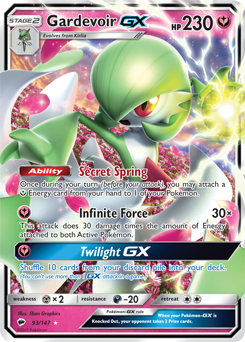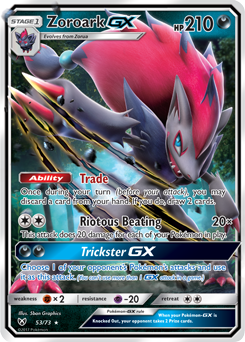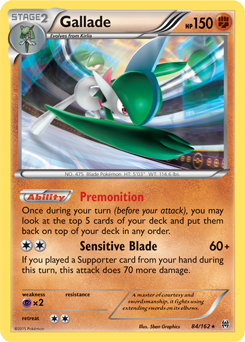The Secret Spring — Gardevoir-GX in Expanded
I’ve had a hard time keeping myself from secretly playing games of Expanded here or there, even when I was testing for Standard events, such as League Cups and Regionals such as Memphis. I just love the format that much. Maybe it’s the familiarity I have with the cards, spanning back to when I first started my Pokemon career in the tail end of the Luxchomp era, and the dawn of the new era of Black and White. But maybe it’s because of the strength of just about every deck, as well as the skill of every player that shines in the format.

I’ve been looking forward to the next expanded event, ever since the last one that I went to – Daytona Regionals. Standard is fun and I’ve been having a blast playing Golisopod-GX / Zoroark-GX, but expanded is my real true love in Pokemon. Sure, it has it’s problems and some not fun interactions. But its large card pool and large amount of options have always kept it exciting to me.
Also, the next event, Dallas Regionals is being played in the Expanded format. I’ve been testing a lot of decks, mostly Zoroark-GX variants, just like everyone else. It’s hard not to gravitate towards it. It’s got a powerful attack with one-shot and two-shot potential. It’s a Stage 1 with possibly the best ability in the game right now. It’s weakness isn’t really being exploited either.
But I’ve also been revisiting and testing an old friend that I have had some success with earlier this season. Gardevoir-GX is one of the few cards that really punishes Zoroark-GX. Its Resistance to Dark, as well as its ability to annihilate anything every turn just makes it incredibly powerful. Its only issues are its consistency, just like in Standard. But in Expanded, we have so many more options to make it consistent. It takes advantage of Gallade as well, which is one of the best attackers in the format. The strengths of Gardevoir-GX are very easy to see, since it’s dominated standard for so long. But I find that it is just as potent in Expanded, with its ability to take on just about any deck as well as it taking advantage of the weaknesses of Zoroark-GX, as well as the rest of the expanded meta.
I’ll offer a short take on my view of the Expanded metagame. Chances are, you’ve been studying it yourself as well, and I don’t find it too hard to see what is going to be popular. I’ll also go over how Gardevoir exploits these decks, as well as ways to make your Gardevoir deck consistent. Of course, I will also be going over my current list, and options to tech into it with what you believe the metagame is going to look like in Dallas.
The State of the Format
If I were to make this similar to a Star Wars-esque opening crawl, I would just start out with this: Zoroark-GX reigns supreme. Zoroark-GX decks will be the most popular deck in Dallas, largely due to how consistent the decks are. Zoroark-GX headlines four of the most popular decks that will be in Dallas. In no order in particular:
- Zoroark-GX / Lycanroc-GX / Sky Field
- Zoroark-GX / Seismitoad-EX / Hypnotoxic Laser
- Zoroark-GX / Alolan Muk / Sky Field
- Zoroark-GX / Golisopod-GX
The first and third decks take advantage of Zoroark’s one-shot potential, as well as its consistency. The second deck is far more disruptive, using Seismitoad-EX primarily with Zoroark either being a finisher, or collecting easy one-shots with Virbank City Gym and Hypnotoxic Laser augmenting Zoroark’s Riotous Beating.
The other big deck of course will be what won the last major American Regional in Expanded. Of course, I’m talking about Night March. This deck never seems to go away, and with the big consistency boost from Zoroark-GX, this deck just got some more resistance against Oricorio, which was really the only card stopping it. Seismitoad-EX‘s Quaking Punch and a Karen combo is still pretty limiting, but now the Night March player can attack with Riotous Beating while they slowly discard their Night Marchers again.

These five decks are going to be the top dogs in the Expanded format, and they all play Zoroark-GX. So what makes Zoroark-GX exploitable? The most obvious weakness is its Weakness alone. Fighting Weakness is much easier to take advantage of in Expanded, since decks are far more consistent and there are just more Fighting Pokemon that can be played.
Gardevoir-GX is an ideal counter to Zoroark. It takes easy one hit Knock Outs against it, has Resistance to Dark, and has 230 HP, so cannot be Knocked Out in one hit. In fact, without a Choice Band, Zoroark has to hit Gardevoir three times thanks to that Resistance. Gardevoir shares the same evolution Pokemon as Gallade too. Gallade presents a serious problem for Zoroark decks with its high HP, and with it being a single Prize attacker. Without a Sky Field or Hypnotoxic Laser, Zoroark decks cannot take an easy Knock Out on Gallade either.
So this is the format now, and how Gardevoir exploits Zoroark. Well, the format in general, since it appears that Zoroark is the format. There are other decks, such as Trevenant making a return. Buzzwole-GX is being used in many decks as well. Players may even stick to old favorites, such as turbo Darkrai-EX, as well as Turtonator-GX decks. Gardevoir-GX can roll with all of these decks. It may suffer a bit against Trevenant, but we will discuss that matchup and my strategies against it later. First I will go over strategies to make Gardevoir consistent, as well as my own deck list.
The Anatomy of a Gardevoir Decklist
So to actually make use of Gardevoir-GX we need to create a decklist that consistently gets it out. Consistency is the key with my Gardevoir lists, since the use of techs aren’t really necessary in a format that Gardevoir should be dominant in. You might have read an article I wrote in the past where I went over a Gardevoir decklist that I used to win a League Cup in Independence, Missouri. My current list is much more consistent than that one, with the greater amount of rounds forcing me to have to make my list that much more consistent.
The list is quite a bit different than when I last played Expanded. This list is incredibly consistent. I’ve played over one hundred games on PTCGO with it and can only count on one hand games where I did not get a Gardevoir-GX out and swinging. You can have bad starts sometimes, where I will say that I need two hands to count the number of times that might have happened, but I still won some of those games by playing out of them. Gardevoir is a very straightforward deck and isn’t too difficult to play, but it takes real skill to play out of a bad start and to not give up. I’ll go over this later.
One Gallade

This could easily be two Gallade as well. This list is highly mutable, and I can easily see cutting something else in the list for a second Gallade. Currently I’m waffling on adding the second one, but one has served me just fine with two Rescue Stretcher in the list. Not to mention, Gardevoir-GX punishes Zoroark-GX as well. I’ve actually taken more Knock Outs against Zoroark-GX with my Gardevoir than my Gallade. Gardevoir needs a little bit of help to take the Knock Out, whereas with Gallade its almost a sure thing. So prizing it isn’t the end of the world, and Zoroark can’t OHKO a Gardevoir anyway. But where the two shines is the Night March matchup. You want to exchange single Prize attackers during this matchup, and if Night March is swinging for 230 or more, then Gallade is the preferred attacker to Knock Out their Marshadow-GX with the help of a Choice Band.
Three Kirlia
I want to draw into Kirlia early and often. Many games I don’t get a turn two Rare Candy into a Gardevoir-GX, but I do get to evolve two Ralts into Kirlia pretty often, which is pretty powerful as well. Having this thick of an evolution line boosts the consistency of this deck, as well as helping it take advantage of Acerola better. Trevenant is making the rounds as well, and that deck plays Espeon-EX, so Kirlia is a much better alternative than to try to get off a Rare Candy play under Item-lock.
One Oranguru
I like this card much more than Octillery. It doubles as a solid attacker, which can be activated fairly easily thanks to Secret Spring, but it also is great for helping you avoid bad N draws late game. It doesn’t need to be evolved, so it’s a bit easier to get mileage out of early. There’s plenty of ways for this deck to get its hand down with Secret Spring helping us get Energy out of our hand, so drawing the one or two cards from Instruct is much easier than you might think.
One Oricorio
Night March. That’s really all I feel that I should say about this card. Oricorio has won me a game or two outside of the Night March matchup as well with its attack being able to put a few damage counters on the board to finish something off, but normally Gardevoir-GX Knocks Out everything in one hit.
This concludes the public portion of this article.
If you'd like to continue reading, consider purchasing a PokeBeach premium membership! If you're not completely satisfied with your membership, you can request a full refund within 30 days.
Each week we post high-quality content from some of the game's top players. Our article program isn't a corporate operation, advertising front, or for-profit business. We set our prices so that we can pay the game's top players to write the best content for our subscribers. Each article topic is carefully selected, goes through multiple drafts, and is touched up by our editors. We take great pride in our program!

